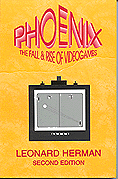
|
|
|
| Videogame History 101
Only about six books tell the story of videogames, and the best of them - Zap and Game Over - are already out of print. Meanwhile, Netscape's Web site lists 6,000 Internet-related titles, and one online bookstore offers two dozen texts relevant to the number 90210. But there is justice in the world: Leonard Herman has written and published an updated edition of Phoenix: The Fall & Rise of Videogames. This labor of love offers a definitive temporal overview of joystick jiggling, covering the ups and downs of the phenomenon from 1962's protogame Spacewar! to antigamer US Senator Joe Lieberman. Phoenix is no Nintendo Babylon; the book mostly covers videogames from the consumer's perspective, one new cartridge at a time. Herman treats popular favorites and dismal flops with even-handed reverence, rarely injecting opinion that could color the facts in any way. I quickly became impatient trudging through such unwavering gray text and read most of the book like I would a reference guide: looking up K-Tel International's double-ender Xonox cartridges, then browsing forward, backward, and sideways for other postdated treasures. Herman's shopping list of obsolete systems and unlikely peripherals includes my personal favorite lost cause: Nintendo's epilepsy-inducing Virtual Boy. Other innovations and oddities include the first uses of off-screen space (Battlezone and Defender, 1980), experiments with bioelectricity (Atari's Mindlink,1984), and the creation of a functional spellchecker for the handheld Game Boy (InfoGenius, 1991). Between these milestones and misfires runs a litany of litigation that could have had Pac-Man gobbling Tums. Instead, videogames survived to spawn a US $1 billion-a-year industry. It seems appropriate that their definitive history is written by a lone button masher. - Ian Christe |